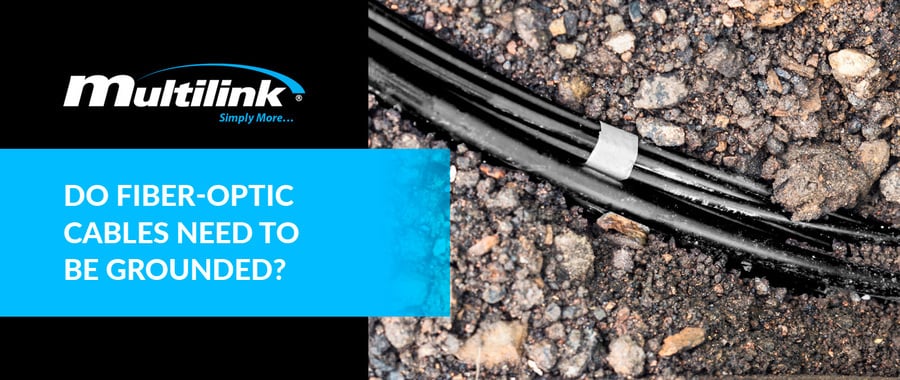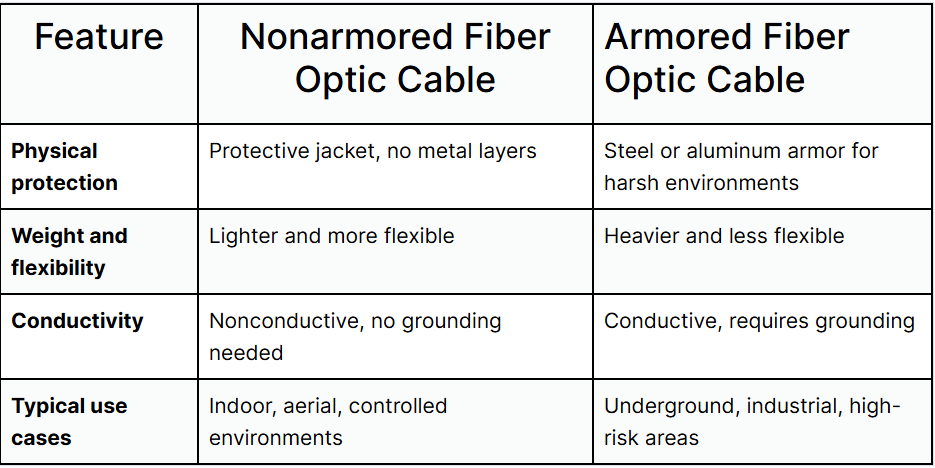{{ quickViewProduct.product_title }}
Stock ID
{{ quickViewProduct.product_stock_number }}
Product Features:
- {{ feature.product_feature_description }}
{{ option.product_option_title }}
{{ value.product_option_value_title }}

While nonarmored fiber optic cables don't require grounding due to their nonconductive properties, grounding is crucial when using armored fiber optic cables. These cables include metallic components that can carry electrical currents, presenting potential hazards such as electrical shock or fire risks if left ungrounded.
Understanding fiber optic cable grounding requirements is essential for protecting your network infrastructure, preventing downtime and maintaining safety on the jobsite. Let's explore how fiber optic systems work, when grounding is required and how to do it correctly.
Fiber optic cables consist of thin strands of fused silica (SiO2) that transmit data as light signals, providing faster speeds and greater bandwidth than traditional copper cables, which transmit data via electrical signals. Fiber optics operate by sending light pulses through the core of the fiber. The core is surrounded by cladding made of the same material but with a different refractive index. This structure keeps light bouncing back and forth in a zig-zag configuration within the core for efficient transmission. This process is known as total internal reflection.
Unlike copper wires, fiber optic cables can maintain higher data integrity over longer distances and under harsh electromagnetic interference (EMI) conditions. This technology also enhances security since bad actors cannot easily tap data transmitted as light.
Fiber optic cables fall into two main categories — armored and nonarmored. Both serve distinct roles depending on the installation environment.
Nonarmored cables feature a protective jacket but no metal components. They are ideal in installations where physical protection isn't a significant concern. These cables are lightweight and flexible, making them easier to install, especially in tight or complex pathways. The absence of a metallic protective outer layer makes fiber cables more cost-effective. However, they require additional protection, such as conduits, in environments where physical damage or tampering is possible.
Since dielectric fiber optic cables are immune to electrical hazards, they are popular for overhead use or in areas exposed to lightning or electrical interference. A good example is an all-dielectric self-supporting (ADSS) cable. Built entirely from nonconductive materials, ADSS is ideal for aerial installations, offering structural integrity without the need for support wires or grounding.
In contrast, armored fiber optic cables feature a steel or aluminum jacket that protects the inner glass fibers from damage. These jackets offer mechanical durability in harsh environments, such as underground or industrial installations, where cables may be susceptible to damage by rodents, construction debris or crushing forces. Armored fiber optic cable grounding is critical because the metal layer can conduct electricity if exposed to lightning strikes or nearby electrical systems.

As we have established, nonarmored or dielectric fiber optic cables do not require grounding because they contain no conductive components. Their dielectric properties provide natural immunity to electromagnetic interference and lightning-induced currents.
In contrast, grounding armored fiber optic cables is mandatory. Proper grounding helps dissipate any stray electrical current, ensuring that it doesn't pose safety hazards, including shock risks to personnel and potential damage to equipment. Grounding also helps prevent the buildup of static electricity that can cause malfunctions in sensitive network equipment or disrupt the signal integrity of the fiber optic cable by attracting dust and contaminants on the end faces.
NEC provides comprehensive guidelines for the grounding of armored fiber optic cables. Specifically, NEC Article 770.93(A) and (B) and 770.100(A) through (D) outline the grounding and bonding requirements for cables with non-current-carrying metallic components, such as those found in armored fiber optic cables.
NEC Article 770.93(A) requires technicians to ground any fiber optic cable at the point of entry to a building. NEC Article 770.93(B) requires service personnel to connect the grounding connection to a reliable and continuous path to the earth or an equivalent grounding system that provides a low-resistance path to dissipate electrical currents safely.
These codes also distinguish between grounding requirements for cables at the building entrance and exterior terminations. For cables entering a building, technicians must connect the bonding or grounding electrode conductor to the building's grounding electrode system. Exterior termination points also require proper bonding to grounding electrodes or an interruption by an insulating joint or equivalent device.
To complete a reliable grounding connection, you'll need:
Here's a brief step-by-step fiber optic cable grounding guide:
Proper fiber optic bonding is also critical to ensure that all metallic components are interconnected before they're grounded. In addition to using the right tools, technicians should avoid common mistakes like improper clamp placement, loose connections, grounding to unapproved surfaces or using undersized wires.
Successful fiber optic cable installation requires adherence to strict safety protocols to protect personnel and equipment.
Fiber optic networks are the foundation of modern communication. While nonarmored fiber optic cables don't need grounding due to their dielectric properties, armored fiber optic cables feature metallic components that must be earthed appropriately to maintain safety and performance. Grounding fiber optic cables protects against electrical hazards, static buildup and lightning strikes, minimizing risks to personnel, equipment and infrastructure.
Multilink is an ISO 9001-certified company with decades of expertise in telecommunications infrastructure. We supply reliable products and expert services tailored to your needs. Our team understands the technical nuances of grounding and bonding armored fiber optic cables and supports you with solutions that optimize installation efficiency and meet code compliance.
We handle design, manufacturing and field service under one roof, ensuring seamless compliance and performance. Contact Multilink today for expert guidance or to schedule a consultation to integrate safe, durable grounding into your next fiber deployment.